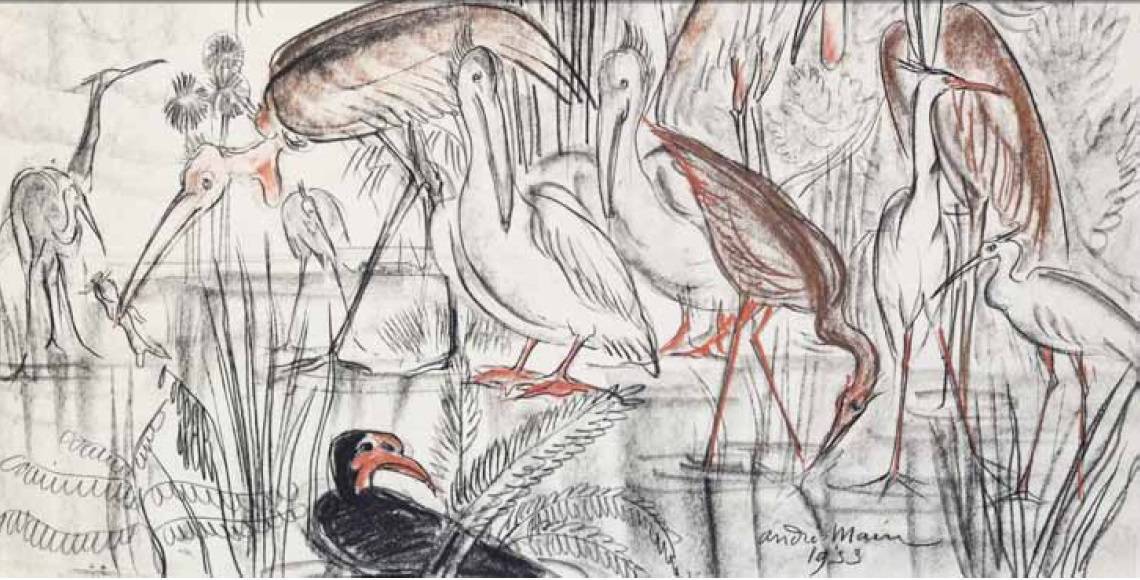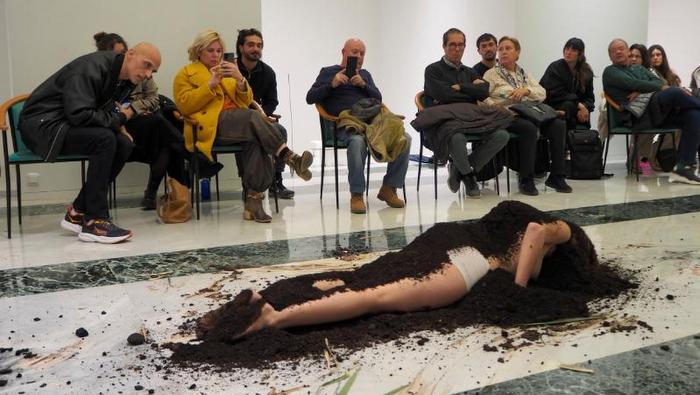Next June, the DUMONTEIL Gallery will present for the first time, within the frame of its DUMONTEIL Art program, an exhibition dedicated to the drawings of André Maire, painter-explorer, the emblematic figure of Art Déco painting of the 20th century.
More than twenty works on paper, from his second trip to Indochina (1948 – 1958), will be exhibited in the centre of DUMONTEIL Gallery’s Paris space. For the occasion, DUMONTEIL Gallery has published work with the sup-port of Bruno Gaudichon, the director of the La Piscine Museum in Rou-baix and Josette Galiège, curator of the Musée de l’Oise. Normal 0 21 false false false EN-US X-NONE X-NONE /* Style Definitions */ table.MsoNormalTable {mso-style-name:"Tabla normal"; mso-tstyle-rowband-size:0; mso-tstyle-colband-size:0; mso-style-noshow:yes; mso-style-priority:99; mso-style-parent:""; mso-padding-alt:0cm 5.4pt 0cm 5.4pt; mso-para-margin:0cm; mso-para-margin-bottom:.0001pt; mso-pagination:widow-orphan; font-size:11.0pt; font-family:"Times New Roman","serif";}
A Travelling Exhibition
The DUMONTEIL Gallery is happy to announce the exhibition “Indochina, Mee-ting Men and Gods,” dedicated for the first time to the works on paper by André Maire (1898 – 1984).
This exhibition, which corresponds to the second part of the artist’s traveling career, was debuted at the DUMONTEIL Gallery’s Shanghai space in September 2016, and follows three museum retrospectives centred around André Maire’s work: at the Musée Cernuschi (Paris, 2012 – 2013), La Piscine Museum (Roubaix, 2009) and the Musée des années 30 (Boulogne-Billancourt, 2001).
A Poetic and Perceptive Perspective
In bringing together more than twenty drawings by André MAIRE, created du-ring his final trip to Indochina, this exhibition proposes an immersion into the creative universe of the adventurous, observant and profoundly humanist artist.
From Laos to Vietnam, and passing through Cambodia, MAIRE’S work gives a perceptive and poetic look at the people, the animals and the places which inspired his work.
Inseparable from his sketchbook, the painter and drawer tirelessly documented his travels in order to, then, reinterpret them, in a larger format, through the prism of his imagination linked to his memories.
A Cultural and Historical Account
In this series, nourished by the in-depth study of Khmer art, emerge scenes of observation of sacred sites and of the locals’ everyday habits, the powerful and elegant stature of the Buddhists.
Through the artist’s gest, his charcoal sceneries, illuminated by the use of red chalk which represent the living, the Buddhas are drawn among the rare pieces of exotic architecture fixed in wild nature. The delicate force of the sketch trans-lates André MAIRE’s profound respect for these ancestral civilizations, witnesses of the richness and diversity of the culture of man.
While the beginning of the 20th century was marked by numerous revolutionary artistic movements, André MAIRE never ceased to represent a form of figurative reality, like an explorer, always curious. Discovering and getting to know his work is not so much entering the creative world of the artist as rediscovering and feeling our world again.
André Maire (1898-1984) painter-explorer
An emblematic figure of Art Déco painting of the twentieth century, André MAIRE is one of those qualified as a painter-explorer. At the Beaux-Arts de Paris, being precocious at a young age he followed the teaching of that which would become his stepfather: Émile Bernard, the major Post-Impressionist painter and writer. Bernard trained him in the classical techniques of painting and, particularly, in the use of colors and the importance of composition.
The quality of André MAIRE’s drawings reflects the profound admiration that he cultivated for the great Italian masters like Le Piranesi. Very early, he found his personal artistic style and freed himself from any kind of influence or creative dogma. The longevity of his career is directly linked to the frequency of his travels, which he carried out throughout his life, an intellectual enrichment and a constant source of inspiration.
Enlisted during World War I, he was sent to French Indochina. It was there he became professor of Arts Plastiques at the College of Saigon and took advantage of his location and traveled the region. This was how he discovered Cambodia and fell under the charm of Angkor, to which he portrays to us his passionate fascination. His numerous drawings of the sacred site were exhibited during the Colonial Exhibition of 1931 in Paris.
When he returned to France, he escaped to Italy, Venice, specifically, as well as Spain. From 1938 to 1945, he explored Egypt, Africa, India and Sri Lanka. From 1948 to 1955, he returned to the city of Saigon where he taught again, but this time at the École Supérieure d’Architecture. During this time, he made a multi-tude of orientalist drawings, but also panels in the accents of Art Déco, at the same time modern, pure and stylized, inspired by Vietnam, Laos and Cambodia.
His talent is well-known for famous charcoals, watercolors and gouaches but also equally for the beauty of his ink and sepia pieces. His works are part of permanent collections and multiple museums.
In 1934, André Maire’s “Le Pont de Tolède” was acquired by the Musée National d’Art Moderne – Centre Pompidou; then, in 1936, the city of Paris for “Espagne
– Pont à Cuenca.” In 1945, the Musée des Colonies enriched its work on Egypt and India while the drawings of Angkor and Africa respectively joined the collec-tions of the Musée Guimet (Musée National des Arts Asiatiques, Musée Branly and Musée d’Art Moderne de Troyes. The piece “La Citadelle” is at La Piscine Museum in Roubaix.
André MAIRE’S work was rich, constructed and dynamic until the end of his life. Like a hymn to the diversity of our cultures and civilizations throughout the world, it celebrates with passion and talent, the spiritual, the earth, animals and men, history and life.
THE BOOK ANDRÉ MAIRE (1898 – 1984) “Indochina”
Work published for the occasion of the exhibition, “Indochina,” by André Maire at the DUMONTEIL Gallery in Shanghai and Paris.
With texts in French, English and Mandarin by:
Pierre DUMONTEIL Joseph GALIÈGUE Bruno GAUDICHON Lorédaria HARSCOÊT-MAIRE
GALERIE DUMONTEIL
The DUMONTEIL Gallery is a modern and contemporary art gallery founded in 1982 by Dothi and Pierre DUMONTEIL. For more than 30 years, the gallery has been situated at 38 rue de l’Université in the heart of the Left Bank’s historic area. They are honoured to have exhibited great sculptors, painters and eminent photographers of the 20th and 21st century, works that regularly and punctually explore the theme of the Animal.
The gallery is renowned for its collective exhibitions and monographs dedicated to artists from 1930 up until the 1970s, from François POMPON to Georges-Lucien GUYOT, as well as Diego GIACOMETTI, Pablo PICASSO, Thierry Van Ryswyck, Armand Petersen, Joseph Czaky, Marcel Derny and Charles Artus, among others.
For more than 20 years, the gallery has dedicated itself to the discovery of and promotion of the best contemporary artists, treating the subject of the Animal figure, along with the theme of Nature. Today, Daniel Daviau, Jean-Marie Fiori, Helmut Koller, Eric Pillot, Jean-Claude Meynard, Rubén Fuentes, Hubert Le Gall and Wang Keping all share, with their formative counterparts, the walls of the gallery’s three international exhibition spaces, in Paris, Shanghai and New York.
Through this, the DUMONTEIL Gallery has become the referential gallery in the promotion of Animal figure representation in art, in France and around the world. Regularly collaborating with museums, numerous publications and participating in several international fairs, including the Biennale des Antiquaires since 1992 and the PAD Paris/London since 1998. The gallery is a member of the Carré Rive Gauche, of CNE and of SNA.
COMING UP FOR THE DUMONTEIL GALLERY















